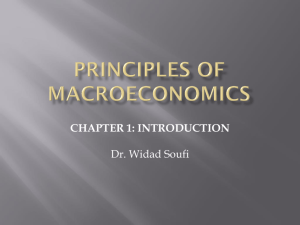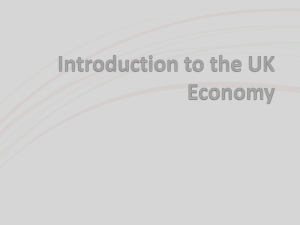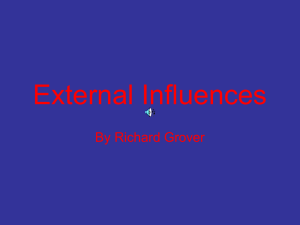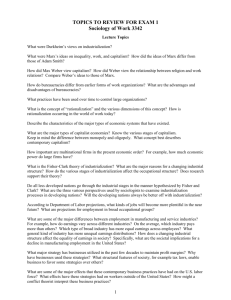Ch 1 - porkrolleggncheese
advertisement
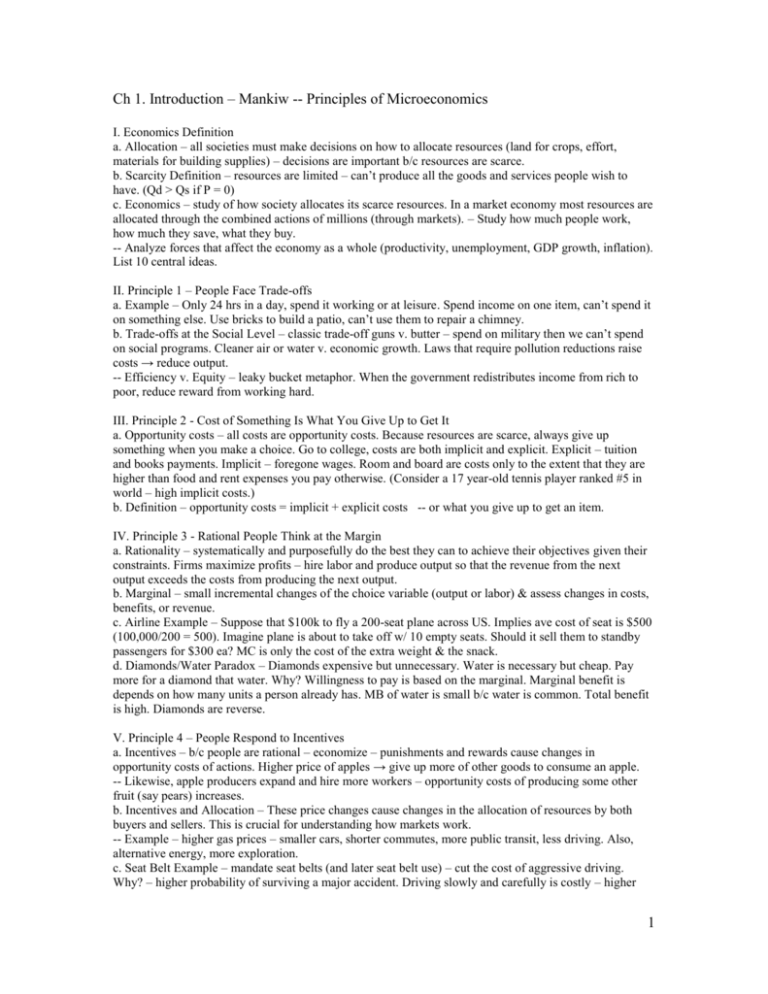
Ch 1. Introduction – Mankiw -- Principles of Microeconomics I. Economics Definition a. Allocation – all societies must make decisions on how to allocate resources (land for crops, effort, materials for building supplies) – decisions are important b/c resources are scarce. b. Scarcity Definition – resources are limited – can’t produce all the goods and services people wish to have. (Qd > Qs if P = 0) c. Economics – study of how society allocates its scarce resources. In a market economy most resources are allocated through the combined actions of millions (through markets). – Study how much people work, how much they save, what they buy. -- Analyze forces that affect the economy as a whole (productivity, unemployment, GDP growth, inflation). List 10 central ideas. II. Principle 1 – People Face Trade-offs a. Example – Only 24 hrs in a day, spend it working or at leisure. Spend income on one item, can’t spend it on something else. Use bricks to build a patio, can’t use them to repair a chimney. b. Trade-offs at the Social Level – classic trade-off guns v. butter – spend on military then we can’t spend on social programs. Cleaner air or water v. economic growth. Laws that require pollution reductions raise costs → reduce output. -- Efficiency v. Equity – leaky bucket metaphor. When the government redistributes income from rich to poor, reduce reward from working hard. III. Principle 2 - Cost of Something Is What You Give Up to Get It a. Opportunity costs – all costs are opportunity costs. Because resources are scarce, always give up something when you make a choice. Go to college, costs are both implicit and explicit. Explicit – tuition and books payments. Implicit – foregone wages. Room and board are costs only to the extent that they are higher than food and rent expenses you pay otherwise. (Consider a 17 year-old tennis player ranked #5 in world – high implicit costs.) b. Definition – opportunity costs = implicit + explicit costs -- or what you give up to get an item. IV. Principle 3 - Rational People Think at the Margin a. Rationality – systematically and purposefully do the best they can to achieve their objectives given their constraints. Firms maximize profits – hire labor and produce output so that the revenue from the next output exceeds the costs from producing the next output. b. Marginal – small incremental changes of the choice variable (output or labor) & assess changes in costs, benefits, or revenue. c. Airline Example – Suppose that $100k to fly a 200-seat plane across US. Implies ave cost of seat is $500 (100,000/200 = 500). Imagine plane is about to take off w/ 10 empty seats. Should it sell them to standby passengers for $300 ea? MC is only the cost of the extra weight & the snack. d. Diamonds/Water Paradox – Diamonds expensive but unnecessary. Water is necessary but cheap. Pay more for a diamond that water. Why? Willingness to pay is based on the marginal. Marginal benefit is depends on how many units a person already has. MB of water is small b/c water is common. Total benefit is high. Diamonds are reverse. V. Principle 4 – People Respond to Incentives a. Incentives – b/c people are rational – economize – punishments and rewards cause changes in opportunity costs of actions. Higher price of apples → give up more of other goods to consume an apple. -- Likewise, apple producers expand and hire more workers – opportunity costs of producing some other fruit (say pears) increases. b. Incentives and Allocation – These price changes cause changes in the allocation of resources by both buyers and sellers. This is crucial for understanding how markets work. -- Example – higher gas prices – smaller cars, shorter commutes, more public transit, less driving. Also, alternative energy, more exploration. c. Seat Belt Example – mandate seat belts (and later seat belt use) – cut the cost of aggressive driving. Why? – higher probability of surviving a major accident. Driving slowly and carefully is costly – higher 1 time costs. Drive more slowly when the benefit of care is higher. Seat belt cuts the benefits of care & we get less care. Classic study by Peltzman showed this effect. d. Infant Seats on Airlines VI. Principle 5 – Trade Can Make Everyone Better Off a. Comparative Advantage – Specialize in activities where you have the lowest opportunity cost. Differences in abilities, resource endowments, etc. cause differences in opportunity costs of producing goods. -- Specialize in what you do best and enjoy a greater variety of goods at lower costs. Other countries are not competitors but rather a source of higher living standards. VII. Principle 6 – Markets Are Usually a Good Way to Organize Economic Activity a. Centrally Planned Economy - works on premise that government officials were in best position to allocate resources. Decide what to produce, how to produce it, quantity produced, and distribution. Theory: only the government could organize activity in a way that would promote well-being for the country as a whole. (Today, most countries have abandoned this system.) b. Market Economy – decisions of the central planner are replaced by decisions of millions of households and firms. Firms decide what to make and who to hire. Consumer demands decide resource allocation, what to produce, how to produce it. Resources go to producers willing to pay the most. Producers can pay more if final demand for their product is higher. Is steel worth more as a refrigerator or as a car? c. Why Does Market Work Well? – Seems like a free-for-all – each individual is out for themselves. In Wealth of Nations – Adam Smith observed that households and firms interact as if they are guided by an invisible hand that leads to desirable outcomes. Basic idea: prices are the instrument through which the invisible hand directs economic activity. Buyers and sellers look at price when deciding how much to buy or produce. Consequently, prices reflect both the value of the good to society as well as the resources used to produce it. Smith’s great idea was that prices adjust to guide individual buyers and sellers and in many cases maximize social welfare. d. Effect of Price Ceilings and Floors – restrictions impede the ability of the invisible hand to coordinate the millions of households and firms that make up the economy. Explains why taxes cause resource misallocation. Also, why rent controls cause harm, and why central planning failed. VIII. Principle 7 – Governments Can Sometimes Improve Outcomes a. Institutions that Support Markets – For instance, property rights and enforceable contracts are necessary to support market exchange. Won’t invest in a factory if the government can expropriate it (i.e., extralegal payments). Patents. Won’t produce music or software if too many customers avoid paying by making illegal copies. b. Intervene to Promote Efficiency – markets sometimes fail to allocate resources efficiently (i.e., market failure) – public goods, common property, market power, and externalities. Externality – unpriced by-product of an economic transaction (electricity & greenhouse gases). Public good – non-depletable & non-excludable (national defense, local roads, parks) Common property - depletable & non-excludable (aquifers, ocean fisheries). Market power- ability of monopoly firms to restrict output and raise price under certain circumstances. c. Intervene to Promote Equity – a market economy rewards according to ability to produce things other people will pay for. Worlds best soccer player earns more than the best dart player. Invisible hand does not ensure that everyone has sufficient, food clothing and shelter. d. Government Failure – just b/c markets are inefficient in a certain case does not imply that governments will improve the situation. Governments fail too. Public policy is not made by angels but by an imperfect political process. Sometimes policies simply reward the politically powerful. Sometimes the policies are ineffective, too costly, or have unintended consequences. -- Good intentions don’t guarantee desired outcomes. Example: try to protect workers by making it difficult for firms to fire or lay off workers. Firms reluctant to hire under such situations & unemployment rises. Example: protect infants & toddlers on commercial airline flights. Require parents to purchase a separate seat for infants and strap them in. Increases total deaths b/c this raises the cost of travel by air for families, they respond by driving where the death rate per mile travelled is significantly higher. IX. Principle 8 – Living Standards Depend on Ability to Produce Goods and Services (Macro) 2 a. Global Differences in Living Standards – in 2003, ave income in US = $37,500, in Mexico, $8,950, in Nigeria, $900. Higher income translates into more goods, better medical care, more education, longer life expectancies, etc. b. Importance of Growth – In US, incomes have historically grown at about 2% per year. Rule of 70 implies that incomes double every 35 years. Large differences in living standards emerge over time b/c of productivity (output per hour worked) differences. -- Productivity is primary determinant of living standards and other forces are secondary (international trade, labor unions, minimum wage laws). -- For example, some complained that competition from Japan explained slow growth in the 70s. Actually, low productivity was the culprit. X. Principle 9 – Prices Rise When Government Prints Too Much Money a. Basic Cause – In almost all cases of large or persistent inflation, the culprit is growth in the quantity of money. In Germany in the 20s, when prices were tripling every month, the quantity of money was tripling every month. In US, high inflation of the 1970s was a direct result of high money growth. XI. Principle 10 – Society Faces a Short Run Trade-off Between Inflation and Unemployment a. Effect of a Monetary Injection (short-run) – 1. More money stimulates overall level of spending & demands for goods & services 2. Immediate effect is firms increase the quantity of goods & services (and more hiring). 3. More hiring – lower unemployment. Thus, higher inflation → lower unemployment b. Trade-off & the Business Cycle – Policymakers can exploit the short-run tradeoff using monetary or fiscal policy. Slower growth →expansionary policy →higher inflation & lower unemployment. → 3

